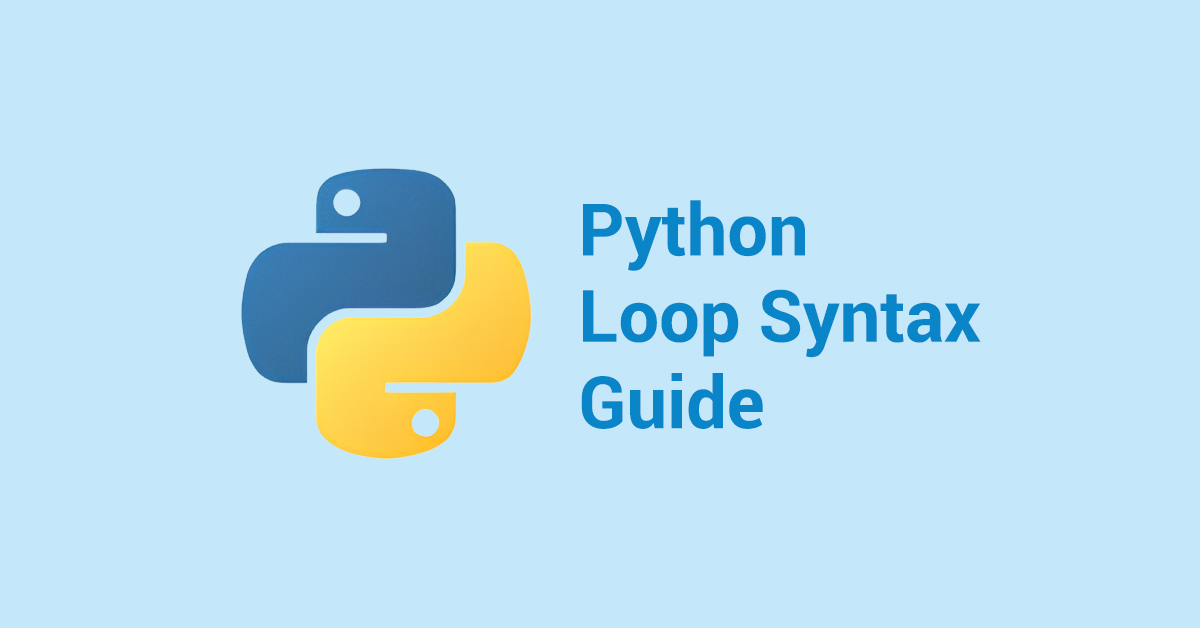Loops are a powerful way to iterate over data, perform repetitive tasks, and bring efficiency to your code. In this article, we will delve deep into Python loop syntax, exploring its types, use cases, and best practices. By the end, you’ll be equipped with the knowledge to wield loops effectively in your code.
Understanding the Basics
In Python, loops help you repeat a block of code multiple times. The two primary types of loops are the for loop and the while loop.
1. The “for” loop syntax
The for loop is used to iterate over a sequence, such as a list, tuple, string, or range. The general syntax is:
for element in sequence:
# Code to be executed for each element
For instance, consider the following code snippet that prints each element of a list:
fruits = ['apple', 'banana', 'orange']
for fruit in fruits:
print(fruit)
Output
apple
banana
orange2. The “while” loop syntax
The while loop repeats a block of code as long as a given condition is True. The syntax is:
while condition:
# Code to be executed while the condition is True
Here’s an example that demonstrates a simple while loop:
count = 0
while count < 5:
print(count)
count += 1
Output
0
1
2
3
4Diving Deeper
Let’s understand other techniques used with Python loops.
1. Loop Control Statements
Python provides powerful control statements that modify the behavior of loops:
a) The break statement
The “break” statement is used to exit the loop prematurely. Here is an example of using the “break” statement in a Python for loop:
for i in range(5):
if i == 3:
break
print(i)
The above code will print numbers 0, 1, and 2, and then terminate the loop when the condition i == 3 is met.
Output
0
1
2b) The continue statement
Skips the current iteration and proceeds to the next one. To use the continue statement in Python, place it within a loop. When the continue statement is encountered, it skips the remaining code within the loop and moves to the next iteration. Here’s an example:
for i in range(1, 6):
if i == 3:
continue
print(i)
This code will print the numbers 1, 2, 4, and 5, skipping the number 3.
Output
1
2
4
5c) The pass statement
Acts as a placeholder, doing nothing. Useful to avoid syntax errors in empty loops.
for i in range(5):
pass
2. Nested Loops
Loops can be nested within each other, enabling you to work with complex data structures. However, excessive nesting can lead to code that is hard to read and debug.
# Nested loop example
for i in range(3):
for j in range(2):
print(i, j)
Output
0 0
0 1
1 0
1 1
2 0
2 13. Looping Techniques
Python offers versatile techniques like enumerate() and zip() to enhance your loop iterations, enumerate() returns both the index and the value of each element, while zip() pairs elements from multiple sequences.
Example of for loop with enumerate :
fruits = ['apple', 'banana', 'cherry']
for index, fruit in enumerate(fruits):
print(f"Index: {index}, Fruit: {fruit}")
Output
Index: 0, Fruit: apple
Index: 1, Fruit: banana
Index: 2, Fruit: cherryExample of for loop with zip:
list1 = [1, 2, 3]
list2 = ['Sunday', 'Monday', 'Wednesday']
for item1, item2 in zip(list1, list2):
print(item1, item2)
Output
1 Sunday
2 Monday
3 WednesdayBest Practices for Effective Looping
These are the some best practices for effective looping :
1. Use List Comprehensions
List comprehensions provide a concise way to create lists using loops. They are more efficient and readable than traditional loops for simple tasks.
In Python, list comprehension is an elegant way to create a new list by iterating over an existing list or other iterable. It’s a concise alternative to using a loop. Here’s an example:
numbers = [1, 2, 3, 4, 5]
squared_numbers = [x**2 for x in numbers]
This creates a new list of squared_numbers with the squares of each element in the numbers list.
2. Opt for range()
When we need to generate a sequence of numbers, the range() function is our friend. It’s memory-efficient and commonly used with “for” loops.
3. Keep It Readable
Readable code is maintainable code. Use meaningful variable names and format your code consistently to enhance readability.
4. Know Your Data Structures:
Different loop types may be better suited for specific data structures. Use “for” loops for sequences and “while” loops when you’re unsure about the number of iterations.
Conclusion
Mastering loop syntax is an essential milestone in your journey to becoming a proficient Python developer. Loops not only simplify repetitive tasks but also empower you to work with diverse datasets and manipulate them effectively.
